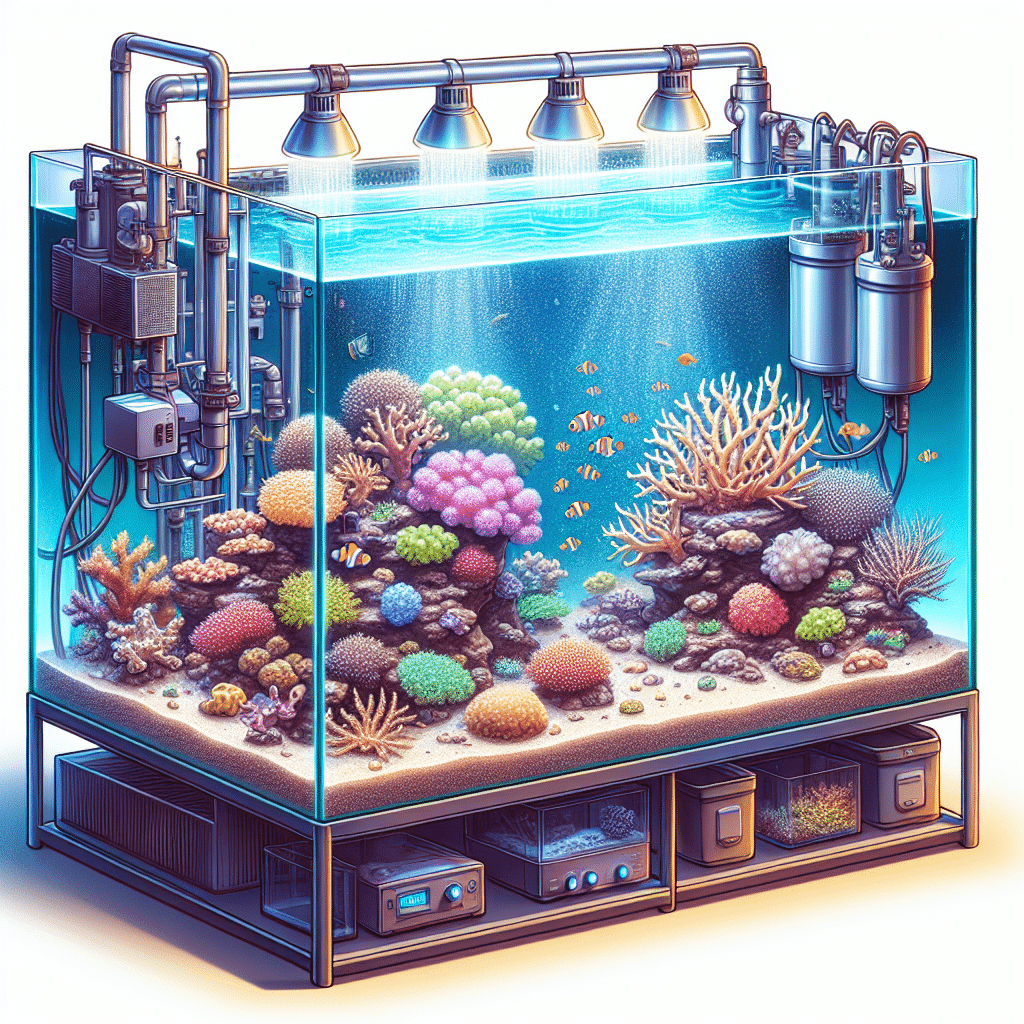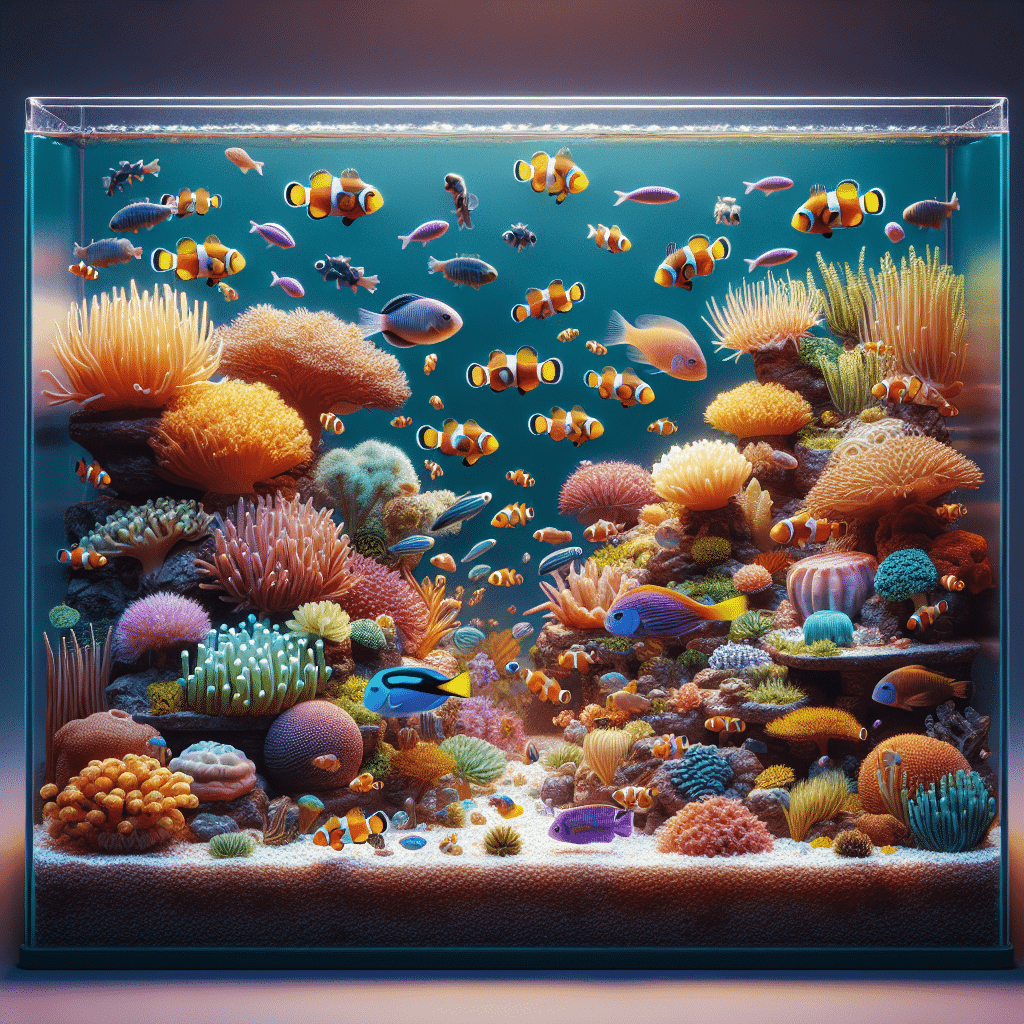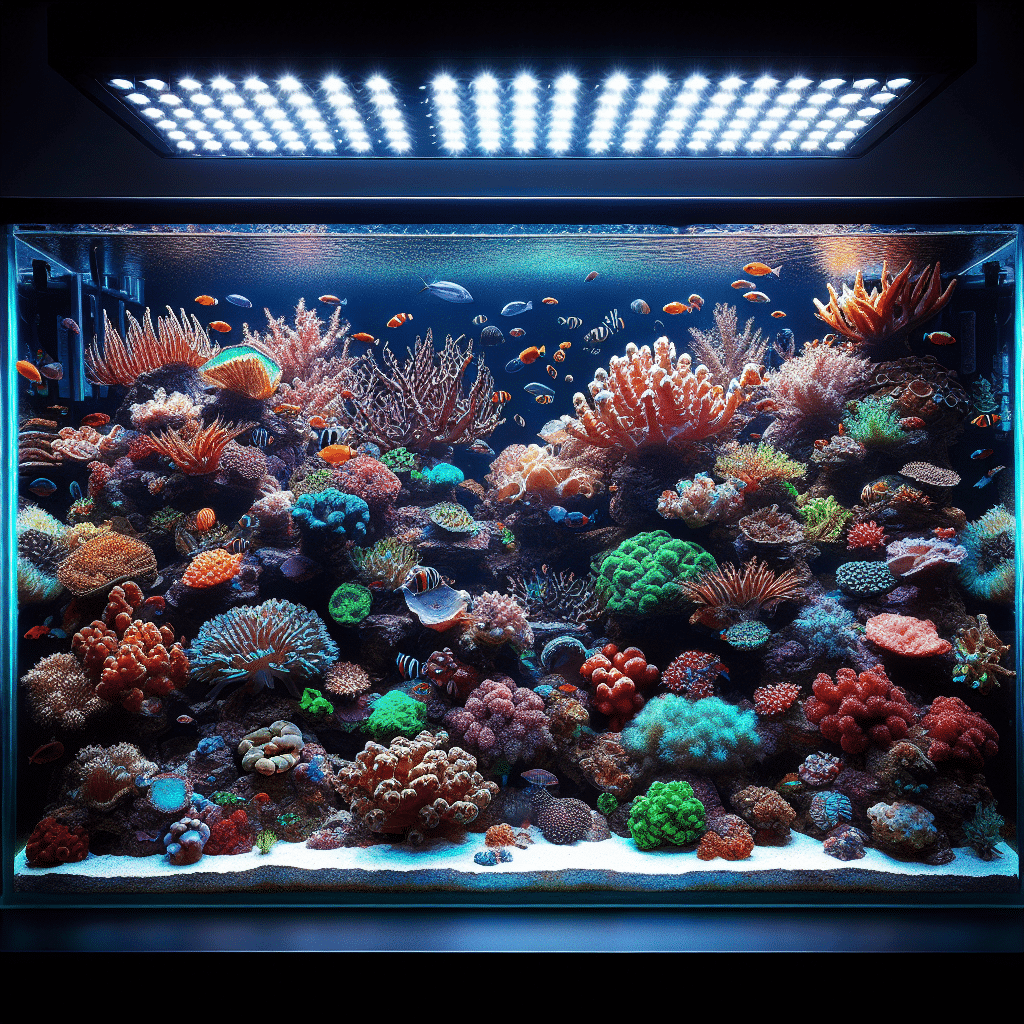Setting Up Your Nano Reef Tank
Creating a successful nano reef tank requires careful planning and the right equipment. This section will cover the ideal tank size and the essential equipment needed for a thriving setup.
Ideal Tank Size
Nano reef tanks are typically small saltwater aquariums, perfect for both beginners and experienced aquarists. They generally range from 2.5 to 30 gallons in size. However, nano reef tanks conventionally refer to systems smaller than 15 gallons, although the term can extend to tanks up to 40 gallons (Live Aquaria, TFH Magazine).
| Tank Size Category | Volume (gallons) |
|---|---|
| Small Nano | 2.5 – 10 |
| Standard Nano | 10 – 15 |
| Larger Nano | 15 – 30 |
Choosing the right size tank is crucial, as smaller tanks require more attention to water quality and stability.
Essential Equipment Needed
Setting up a nano reef tank involves gathering essential equipment to ensure a healthy environment for marine life. The bare minimum supplies needed for a nano aquarium setup include:
| Equipment | Purpose |
|---|---|
| Aquarium | The main container for the marine life |
| Powerhead or Wave Maker | Creates water movement and circulation |
| Refractometer | Measures the salinity of the water |
| Quality Reef Lighting | Provides light for corals and plants |
| Sand or Bare Bottom | Substrate for the tank |
| RO/DI Water or Distilled Water | High-quality water source |
| Reef Aquarium Salt Mix | For salinity adjustment |
| Live Rock | Provides habitat and biological filtration |
| Filter | Maintains water quality |
| Heater | Regulates water temperature |
For enhanced performance, consider adding optional items such as an aquarium lid or screen cover, Purigen, carbon or other filter media, an automatic top-off system for evaporation, a sump for external filtration, a protein skimmer, a backup heater, and basic medications if keeping fish (Nano-Reef).
Investing in the right nano reef tank equipment will help create a stable environment for your aquatic inhabitants, leading to a successful and enjoyable nano reef tank setup.
Selecting Corals for Your Nano Reef Tank
Choosing the right corals for a nano reef tank is essential for creating a vibrant and balanced ecosystem. In this section, the best corals for nano tanks will be discussed, along with important considerations for coral selection.
Best Corals for Nano Tanks
Nano reef tanks can accommodate a variety of corals, making them an excellent choice for enthusiasts looking to create a miniature reef. Some of the best coral options for these setups include:
| Coral Type | Description |
|---|---|
| Acropora | Fast-growing, colorful stony corals. |
| Hammer Coral | Soft coral with distinctive tentacles. |
| Montipora | Hardy stony coral, easy to care for. |
| Mushrooms | Soft, adaptable corals that thrive in low light. |
| Torch Coral | Beautiful, flowing tentacles; prefers moderate light. |
| Xenia | Pulsing, soft coral that grows quickly. |
| Zoanthids/Palys | Colorful polyps that can spread quickly. |
These corals not only enhance the aesthetic appeal of a nano reef tank but also contribute to the overall health of the tank by providing habitat and food for various marine life. For more information on suitable coral options, visit our page on nano reef tank corals.
Considerations for Coral Selection
When selecting corals for a nano reef tank, several factors should be considered to ensure the success of the setup:
Tank Size: Nano reef tanks have limited space, so it is important to choose corals that will not outgrow the environment. Some corals, like Acropora, grow rapidly and need ample space to thrive.
Water Parameters: Corals have specific water quality requirements, including temperature, salinity, and pH levels. Maintaining stable conditions is crucial, as rapid changes in water chemistry can adversely affect coral health (Live Aquaria).
Lighting Needs: Different corals have varying light requirements. It is essential to provide appropriate lighting for the selected corals to ensure their growth and coloration. For guidance on lighting options, refer to our article on nano reef tank lighting.
Compatibility: Some corals may not coexist well with others due to aggression or differing care requirements. Researching compatibility is vital to prevent conflicts among tank inhabitants.
Maintenance: Proper care and attention to detail are critical for the success of a nano reef tank. Regular monitoring and maintenance routines help maintain water quality and support coral health.
By carefully selecting corals suited for nano reef tanks and considering these important factors, hobbyists can create a thriving miniature reef ecosystem that is both beautiful and sustainable. For additional insights into maintaining a healthy nano reef tank, check our guide on nano reef tank maintenance.
Maintaining Water Quality in Your Nano Reef Tank
Maintaining proper water quality is crucial for the health of a nano reef tank. This section will cover the key aspects of monitoring water parameters and managing water changes to ensure a thriving aquatic environment.
Monitoring Parameters
Regular monitoring of various water parameters is essential to maintain stability in a nano reef tank. Key parameters include temperature, salinity, pH, ammonia, nitrite, nitrate, and phosphate levels. Keeping these parameters within the recommended ranges helps ensure the health of corals and other marine life.
| Parameter | Ideal Range |
|---|---|
| Temperature | 76°F – 82°F (24°C – 28°C) |
| Salinity | 1.024 – 1.026 specific gravity |
| pH | 8.1 – 8.4 |
| Ammonia | 0 ppm |
| Nitrite | 0 ppm |
| Nitrate | < 5 ppm |
| Phosphate | < 0.03 ppm |
Nano reef tanks require careful maintenance to ensure stability in the system, which can be achieved through proper setup and monitoring of these parameters (Reef2Reef). Regular testing using reliable kits or digital monitors can help identify any fluctuations early.
Water Changes and Nutrient Control
Water changes are a fundamental practice for maintaining water quality in a nano reef tank. It is recommended to perform water changes of 10-20% per week to remove waste and replenish essential trace elements (Nano-Reef). When changing water, using clean, natural saltwater or artificial saltwater is highly advisable.
To maintain a balanced system, it’s important to match food input with water changes and detritus removal. This practice helps control nitrate and phosphate levels, preventing algae blooms and ensuring a healthy environment for the tank’s inhabitants (Nano-Reef).
By diligently monitoring water parameters and performing regular water changes, one can create an optimal environment for the success of their nano reef tank. For further information on maintaining a healthy setup, consider reviewing our articles on nano reef tank equipment and nano reef tank maintenance.
Caring for Inhabitants of Your Nano Reef Tank
Successfully maintaining a nano reef tank involves careful consideration of the livestock introduced into the environment. This section discusses the introduction of livestock and the proper stocking order to ensure a thriving ecosystem.
Introduction of Livestock
When adding inhabitants to a nano reef tank, it is crucial to follow a systematic approach. It is advisable to start with invertebrates such as snails and crabs. These species help to maintain cleanliness by consuming algae and detritus. After establishing these initial inhabitants, fish can be introduced, followed by corals.
Adding new livestock should be done gradually to allow the tank’s ecosystem to adapt. To prevent overstocking, it is recommended to add at most two new inhabitants per week. This approach helps maintain water quality and reduces stress on the existing inhabitants. Initial selections should focus on beginner-friendly species to ensure a smoother start.
| Livestock Type | Recommended Species |
|---|---|
| Invertebrates | Snails, small hermits, peppermints |
| Fish | Fairy wrasses, grammas, cardinals, gobies, dartfishes, certain damselfishes |
For more information on the best fish options, check our article on nano reef tank fish.
Proper Stocking Order
The order in which livestock is introduced plays a significant role in the health of the nano reef tank. Following the recommended stocking order helps to minimize territorial disputes and stress among the inhabitants.
- Invertebrates: Start with snails and small crabs. They will help with algae control and tank cleaning.
- Fish: Introduce compatible fish species next. Choose from options like fairy wrasses, grammas, or cardinals, which are known to coexist well in smaller tanks.
- Corals: Finally, after the fish are established and the tank’s conditions are stable, corals can be added. This ensures that the corals receive the appropriate light and water conditions without competition for space and resources.
Following this stocking order not only supports the health of the tank but also enhances the overall visual appeal. For further insights on creating a balanced ecosystem, refer to our article on nano reef tank stocking.
Maintenance Tips for a Thriving Nano Reef Tank
Maintaining a nano reef tank requires diligence and attention to detail. The small volume of water in these setups can lead to rapid changes in water chemistry, making regular maintenance essential for the health of both corals and fish.
Cleaning Procedures
Regular cleaning is a key component of maintaining a nano reef tank. This includes tasks such as removing detritus, cleaning the aquarium glass, and maintaining skimmers.
- Detritus Removal: Accumulated waste can impact water quality. Techniques for removing detritus include:
- Using a turkey baster or powerhead to clean live rock.
- Employing a siphon hose or gravel vacuum for live sand.
Skimmer Maintenance: Cleaning the skimmer cup prevents buildup and ensures effective filtration. It is advisable to clean skimmer cups weekly or bi-weekly.
Glass Cleaning: Regularly wipe down the aquarium glass to prevent algae growth. This can be done using a soft cloth or aquarium-safe scraper.
Water Changes: Conducting regular water changes is vital. Aim for 10-20% changes weekly to maintain water quality (Live Aquaria).
| Maintenance Task | Frequency |
|---|---|
| Detritus Removal | As needed |
| Skimmer Cleaning | Weekly/Bi-weekly |
| Glass Cleaning | Weekly |
| Water Changes | 10-20% weekly |
Pump Maintenance and Balance
Proper maintenance of pumps is crucial for ensuring consistent water flow and filtration. Regular cleaning of pumps can prevent clogs and maintain their efficiency.
Disassembly and Cleaning: It is recommended to disassemble and clean pumps every 2-3 months. If the tank has a high bio-load, this may need to be done more frequently (Nano-Reef).
Checking Output: Monitor the output of pumps to ensure they are functioning correctly. A decrease in flow can indicate a need for cleaning.
Balance with Equipment: Ensure that the pump’s output matches the needs of the aquarium’s filtration and flow requirements. This helps in preventing dead spots where debris can accumulate.
By following these maintenance tips, individuals can ensure a thriving environment for their nano reef tank inhabitants. Regular cleaning and pump maintenance will contribute significantly to the overall stability of the system, which is essential for successful coral growth and fish health. For more information on maintaining your setup, visit our article on nano reef tank maintenance.
Advanced Tips for Nano Reef Tank Success
Successfully maintaining a nano reef tank requires attention to detail and an understanding of specific practices that enhance the setup and ensure the health of its inhabitants. The following sections provide advanced tips for optimizing a nano reef tank.
Enhancing Setup with Optional Items
While the essential equipment is critical for a nano reef tank, optional items can significantly enhance the overall environment. Some recommended additions include:
| Optional Item | Purpose |
|---|---|
| Reef Skimmer | Removes organic waste, improving water quality. |
| Refugium | Provides a habitat for beneficial organisms and helps with nutrient control. |
| Chiller | Maintains stable water temperatures, especially in warmer climates. |
| Auto Top Off System | Automatically replenishes evaporated water, ensuring stable salinity. |
Integrating these optional items can lead to improved stability and health for the ecosystem within the tank. Regular maintenance is still essential, as improper care can lead to rapid changes in water chemistry, which is particularly critical in a small volume of water.
Cycling Process and Adding Livestock
Before introducing any inhabitants into the nano reef tank, it is essential to complete the cycling process. This process involves establishing beneficial bacteria that convert harmful ammonia into nitrites and then into less toxic nitrates. The following steps outline this process:
- Set Up the Tank: After assembling all equipment and adding substrate and decorations, fill the tank with saltwater.
- Introduce a Source of Ammonia: This can be done by adding a small amount of fish food or pure ammonia to kickstart the nitrogen cycle.
- Monitor Water Parameters: Regularly check ammonia, nitrite, and nitrate levels. The tank is ready for livestock once it shows zero ammonia, zero nitrites, and under ten nitrates (Nano-Reef).
- Add Livestock Gradually: Introduce fish and corals slowly, allowing time for the tank to adjust to the added bioload. This gradual approach helps maintain water quality and stability.
For a comprehensive understanding of fish selection, refer to our article on nano reef tank fish and for coral options, check nano reef tank corals. Regular monitoring of water parameters, feeding sparingly, and conducting maintenance tasks like cleaning the skimmer cup and performing water changes (typically 10-20% per week) are also crucial for a thriving nano reef tank (TFH Magazine, Nano-Reef).



